What to do if sauerkraut is too salty
Pleasant taste and high quality of the dish are guaranteed only by competently executed fermentation. But it happens that the taste of the prepared product is very far from what is desired. Among most common mistakes for beginner cooks - oversalting.
From the article you will learn what to do if sauerkraut is over-salted and how to avoid it.
Features of sauerkraut
Not all varieties of white cabbage are suitable for pickling - choose mid- and late-ripening varieties. Such heads of cabbage consist of dense leaves, so the workpiece turns out crispy and is stored longer.
Not only the taste, but also the shelf life depends on the amount of salt. With insufficient salt, the fermentation process occurs faster, but the vegetable itself becomes soft and tasteless.
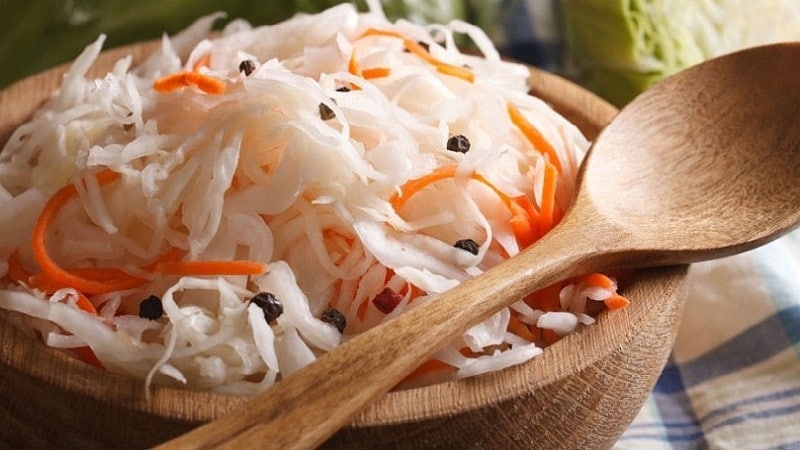
Preparation for fermentation includes choosing vegetables, containers, adjusting the temperature and determining the place where the container with the starter will be located.
What rules are followed when fermenting?:
- when cooking use rock salt coarsely ground - iodized makes the cabbage soft and tasteless;
- Do not wash the cabbage before cutting, just remove a few top leaves;
- the containers in which the workpiece will be stored are treated with vinegar or alcohol with the addition of vegetable oil;
- chopped vegetables are carefully mixed with salt;
- daily pierce the workpiece a wooden skewer to release accumulated gases;
- remove the foam that forms during fermentation;
- The jar in which the fermentation is made is placed on a wide plate so that the brine during the fermentation stage does not spill onto the table or other surface.
Why does oversalting happen?
Over-salting during fermentation occurs quite often. It depends not only on the housewife, but also on the quality of the vegetable. Good fermentation requires experience, but no one is immune from mistakes.
Reasons for oversalting:
- the wrong, untested fermentation recipe was chosen;
- iodized salt was used for salting;
- fermented longer, than necessary;
- from the moment the foam appeared, the first puncture was not made to release gases;
- Due to the strong pressing of the ingredients, the salting did not have enough air.
Attention! If you use sea salt, remember to use half as much.
What to do if you over-salted cabbage
Oversalting is a common problem, so there are many ways to correct the situation. We will tell you further what the housewife should do if she oversalts the cabbage when pickling.

If discovered immediately
The salting is checked for the degree of salinity immediately after the mixture produces juice.. First try the brine, since it contains the bulk of the salt. If oversalting is detected, one of the methods for eliminating it is used.
Adding water
If the brine turns out to be too salty, drain the third part from the container and add the same amount of settled cool water.
Important! You cannot drain the brine completely, because this will make the cabbage bland and tasteless.
When mixing water and brine, its concentration decreases. To distribute the brine diluted with water, shake the container. This method is only suitable if you ferment in small containers - shaking the barrel will be difficult.
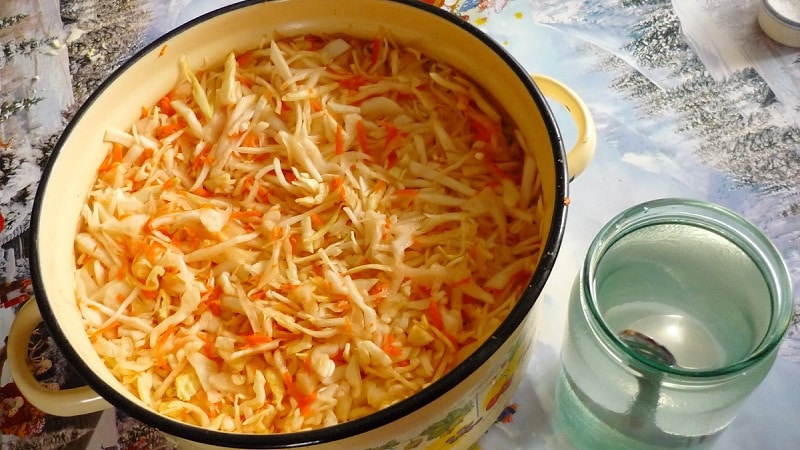
Egg method
A raw chicken egg is broken into gauze folded in half. Instead of gauze, a waterproof bag is also used. The package with the contents is placed in a container with cabbage for 10-15 minutes.. During this time, the egg will draw out most of the salt. It is important to monitor the process, because if the egg leaks, the salting will be lost.
Important! The time the egg spends in salting must not be exceeded; it must be strictly 15 minutes. With prolonged interaction, the microflora of eggs has a negative effect on the fermentation conditions.
Transfer to a large container
When vegetables are heavily compacted, the air needed for fermentation stops flowing to the lower layers.. The first thing they do in this situation is to transfer the contents of the jar into a larger container. Add grated carrots and fresh shredded cabbage, mix the ingredients and place under a press. Fresh vegetables will absorb excess salt and the taste will become milder.
Soak
The salted vegetable is soaked for 30 minutes.. Before serving, rinse additionally several times and add granulated sugar, which will soften the saltiness of the dish.
If you didn't find it right away
It is useless to rinse the workpiece and add vegetables to it if you noticed the oversalting already in winter when you opened the jar. In this case, cabbage is immediately added to main dishes.
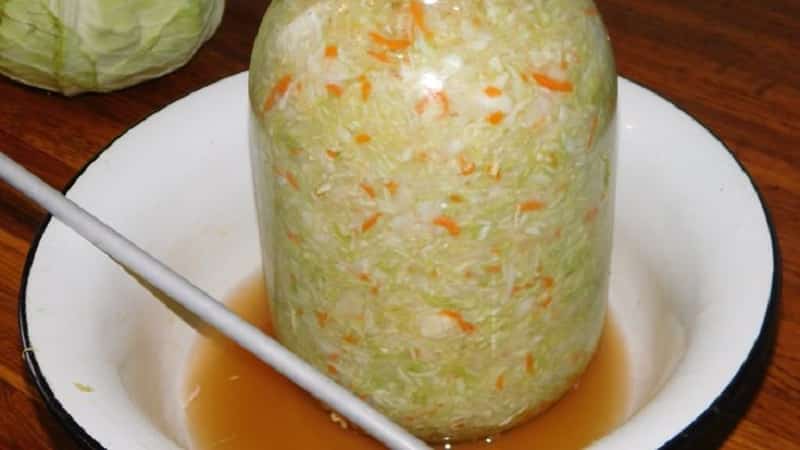
How to save over-salted cabbage
Sauerkraut, which was discovered too late, can only be saved by the right main course.: for example, borscht, vinaigrette, cabbage soup or stew. To prepare meat with cabbage, many cooks specially add salt to the preparation.
To serve sauerkraut as an independent snack, use a large amount of vegetable oil, add onions.
Interesting things on the site:
How to avoid oversalting
To avoid oversalting the cabbage, follow the rules:
- choose a proven recipe and use measuring cups;
- prefer late varieties of cabbage;
- choose heads from 800 g to 2 kg;
- do not take cabbage with signs of rotting;
- taste the product during all stages of salting;
- shredded cabbage is ground until the juice is released before putting it under pressure;
- punctures are made in time to release the gases formed during fermentation.
Tips and tricks for sauerkraut
The process of sauerkraut is carefully controlled. Kitchen utensils used: knives, chops - must be clean. They begin to ferment cabbage no earlier than the first half of October - at this time it becomes crispy and aromatic.
When cleaning a head of cabbage remove several large sheets and place them on the bottom of the fermentation pan - this way you will get more juice.
To make delicious sauerkraut adhere to basic recommendations.
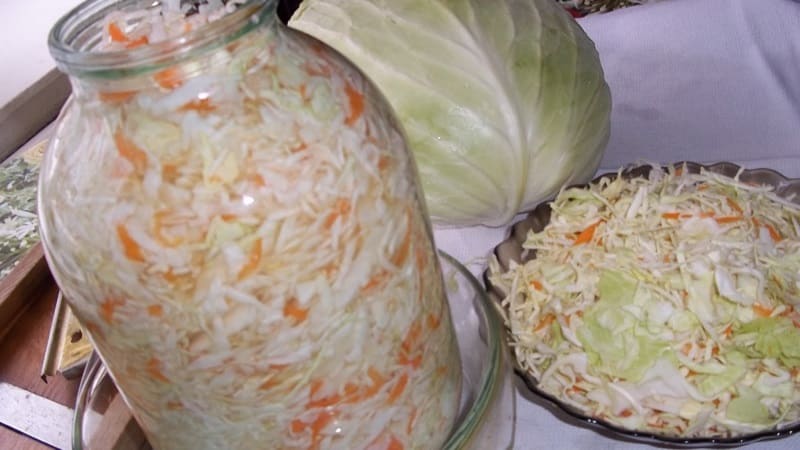
Preparatory stage
Choose a suitable container – a large saucepan or other glass or enameled steel container. Plastic and metal containers are not used, as they can give off their odor and oxidize.
Used as a press three-liter jar of water. Loads in the form of stones or metal are not suitable. Pre-prepared linen or cotton fabric is placed between the load and the starter.
Iodized and evaporated salt is left for other recipes. For pickling cabbage, they use stone cabbage - it does not impart bitterness.
Selection and purchase of vegetables
Cabbage for pickling should be of late varieties: dense white head without cracks, traces of soil contamination, damage by slugs, caterpillars, signs of rotting.
Carrots are suitable juicy, bright orange color. For 1 kg of cabbage take one small carrot.
Shredding
The head of cabbage is cleared of the top leaves and cut into two equal parts. Finely chop the cabbage: the strips should be long and thin. Carrots are grated and mixed with cabbage.
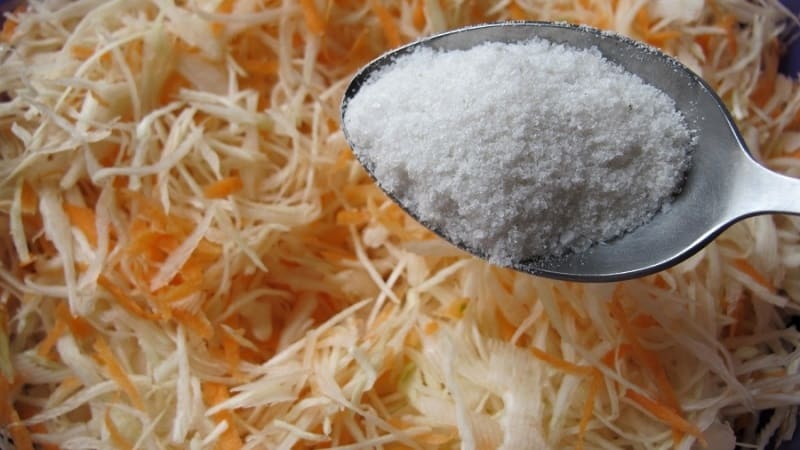
Amount of salt and ingredients
Salt is added according to 20-25 g per 1 kg of cabbage, but you can follow your taste preferences. A strong deviation from the norms will affect the over-salting or under-salting of the workpiece. If the cabbage is not salted enough, it will go rotten.
Vegetables are evenly salted and mixed. To quickly start fermentation, add sugar at the tip of the knife. Then mix again and knead until the juice is released. At the end, taste it and add salt if necessary. If additional vegetables are added to the pickling, their volume should not exceed 1/4 of the volume of cabbage.
Read also:
How to remove bitterness from sauerkraut and why it appears
Bookmark in container
The pan or jar is washed and treated with vinegar. Vegetables are placed closely in the container, all new layers are pressed together.
The cabbage is placed leaving 10 cm from the top of the container so that the juice does not spill out during fermentation. Place a plate on top and press it tightly with a weight (a jar of water, a saucepan, etc.).
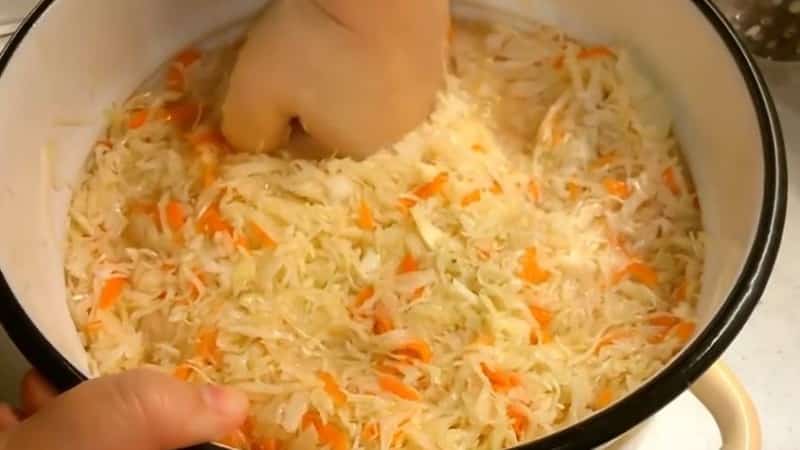
Fermentation
To speed up the fermentation stage, place the container closer to the heat. For systematic ripening, the temperature must reach +15°C. After 2-3 days, the salting will fill with gas, and foam will form on top. At this stage, the gas must be released.To do this, remove the weight and the plate underneath it, and pierce the mass to the very bottom with a wooden stick. They compact the vegetables and place the load in place.
When the workpiece is ready, it is laid out in jars and leave in a cool place.
Conclusion
You can correct over-salted sauerkraut both during fermentation and after a few days. If oversalting is discovered too late, you will have to choose a suitable dish and use the preparation as it is. When preparing pickled vegetables, it is recommended to follow the recommendations for choosing heads of cabbage, containers, maintaining proportions and controlling fermentation to avoid over-salting.